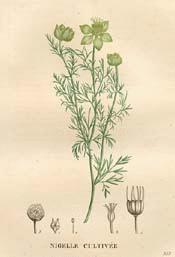
Botanical.com Home Page
Fennel Flower
Botanical: Nigella sativa (LINN.)
Family: N.O. Ranunculaceae
---Synonyms---Roman Coriander. Nutmeg Flower.
(French) Faux cumin. (Quatre épices. Toute épice.
(German) Schwarzkummel.
---Parts Used---Seeds, herb.
Fennel Flower, or Nutmeg Flower, is a small Asiatic annual, native to Syria, not in any way related to the Fennel, but belonging to the buttercup order of plants and grown to a limited extent in southern Europe and occasionally in other parts of the world.
Among the Romans it was esteemed in cooking, hence one of its common names, Roman Coriander.
French cooks employ the seeds of this plant under the name of quatre épices or toute épice. They were formerly used as a substitute for pepper.
---Description---The plant has a rather stiff, erect, branching stem, bears deeply-cut greyish-green leaves and terminal greyishblue flowers, followed by odd, toothed seedvessels, filled with small somewhat compressed seeds, usually three-cornered, with two sides flat and one convex, black or brown externally, white and oleaginous within, of a strong, agreeable aromatic odour, like that of nutmegs, and a spicy, pungent taste.
---Cultivation---The seed is sown in spring, after the ground gets warm. The drills may be 15 to 18 inches apart and the plants thinned to 10 to 12 inches asunder. No special attention is necessary until mid-summer when the seeds ripen. They are easily threshed and cleaned. After drying, they should be carefully stored in a cool, dry place.
---Constituents---The chief constituents of the seeds are a volatile oil and a fixed oil (1.3 per cent of the former and 35 per cent of the latter), and an amorphous, glucoside Melanthin, which is decomposed by diluted hydrochloric acid into Melanthigenin and sugar. Rochebrune, Toxicol Africaine, has found a powerful paralysing alkaloid, to which he gives the name of Nigelline. Melanthin is stated to exhibit the typical physiological action of the most poisonous saponines.
---Medicinal Action and Uses---In India, the seeds are considered as stimulant, diaphoretic and emmenagogue, and are believed to increase the secretion of milk. They are also used as a condiment and as a corrigent or adjuvant of purgative and tonic medicines.
In Eastern countries they are commonly used for seasoning curries and other dishes, and the Egyptians spread them on bread or put them on cakes like comfits, believing them to be fattening. They are also used in India for putting among linen to keep away insects- and the native doctors employ them medicinally as a carminative in indigestion and bowel complaints.
[Top]
Common Name Index
A MODERN HERBAL Home Page
Bear in mind "A Modern Herbal" was written with the conventional wisdom of the early 1900's. This should be taken into account as some of the information may now be considered inaccurate, or not in accordance with modern medicine.
© Copyright Protected 1995-2025 Botanical.com
|


